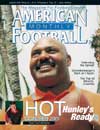Article CategoriesAFM Magazine
|
Stop the SpreadWhat defenses are doing to attack the latest craze in offense - the spreadby: Darryl Richards © More from this issue Kansas State defensive coordinator Phil Bennett has been a popular man this off-season. Not a week goes by without another coordinator calling for some advice on defending an offense that was hard to tackle last season. It is an offense responsible for Oklahoma winning the national title, Oregon State completing its best season in school history, Purdue going to the Rose Bowl, and both Northwestern and South Carolina rising from the depths. It's the spread offense and the debate on how to, at least, slow it down has coordinators sharing information like a hot stock tip. "I've had at least 20 staffs call to come down and visit with me," said Bennett, who couldn't handle the requests because of family obligations. "I've shared a lot of ideas over the phone because that's the way the business is. Football is a game of evolution....The full article can only be seen by subscribers.
|
|
|||||||
| HOME |
MAGAZINE |
SUBSCRIBE | ONLINE COLUMNISTS | COACHING VIDEOS |
Copyright 2025, AmericanFootballMonthly.com
All Rights Reserved





